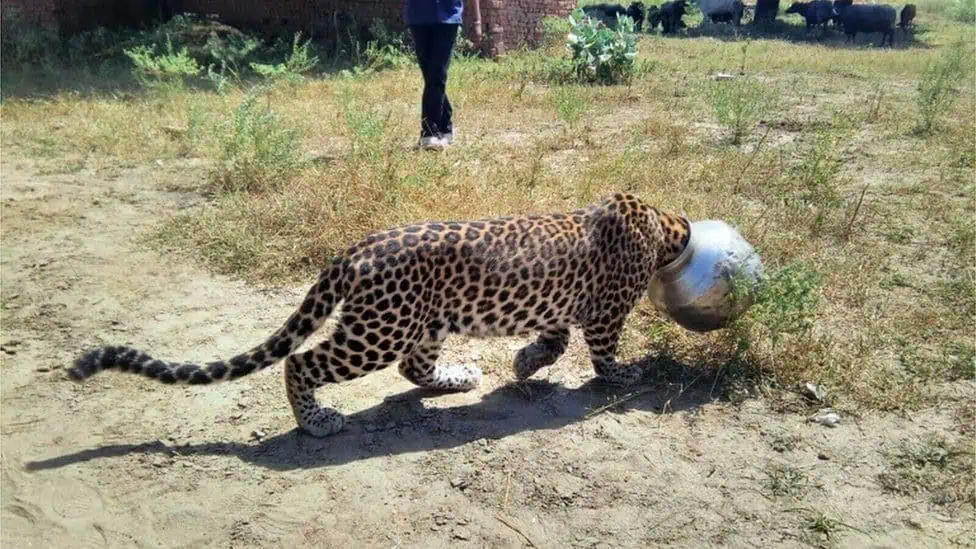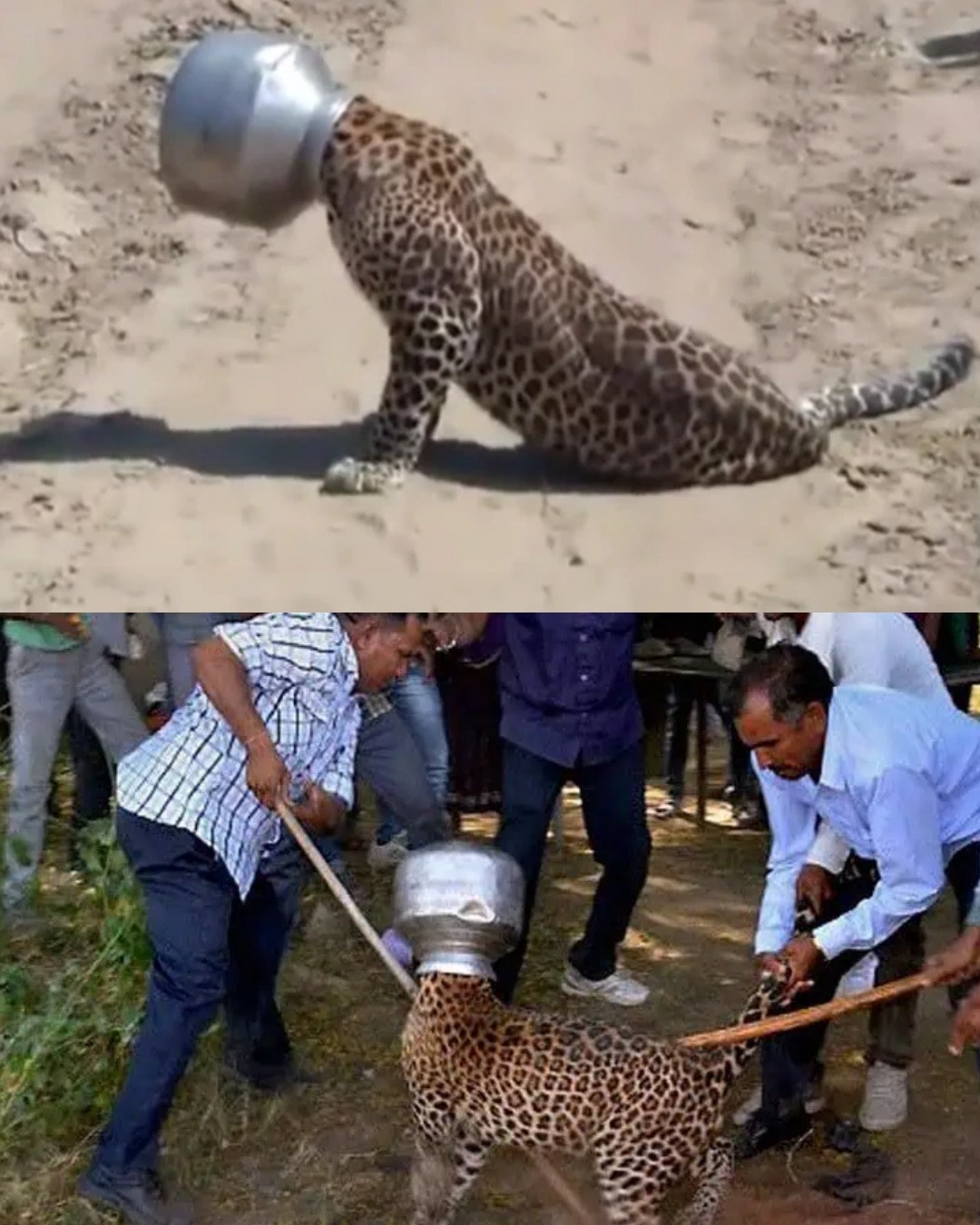A Morning Like No Other
In a quiet village in India, the dawn of a seemingly ordinary day quickly gave way to chaos, curiosity, and concern. Residents were roused from their morning routines by a commotion unlike any they had witnessed before — a leopard had wandered into the settlement. Initial panic and confusion rippled through the narrow streets as villagers tried to understand the unusual visitor. But as they approached, they discovered something both startling and strangely amusing: the young leopard had its head stuck inside a metal pot.
The animal, a male estimated to be about three years old, had descended from nearby forested hills in search of water. Seasonal droughts had left many natural sources dry, and the pot — used by the villagers to collect rainwater — seemed like a promising solution. Yet in its desperation, the leopard became trapped, its powerful jaws and muscular neck wedged firmly inside the container. What began as a quest for survival quickly transformed into a spectacle that drew villagers from every corner of the area.
The sight was at once alarming and surreal. Shining metal obscured the leopard’s face as it staggered down narrow lanes, pawing, twisting, and vocalizing in frustration. Its roars, a mix of fear and frustration, echoed through the village, unnerving some onlookers while amusing others. Some villagers attempted to approach, but caution prevailed — the wild predator was unpredictable, and safety had to come first.

The Delicate Art of Rescue
The local Forest Department was alerted promptly, and a team of experienced wildlife officers, led by District Forest Officer Kapil Sharma, was dispatched. They faced a situation that required extreme care. Any sudden movement or misjudgment could startle the already frightened leopard, putting both the animal and human onlookers at risk.
Tranquilization was chosen as the safest approach. From a secure distance, the officers administered a sedative, allowing them to wait while the young leopard gradually succumbed to its effects. Once the animal lay still, the rescue team moved in with a combination of veterinary expertise and caution. Using specialized tools, they carefully loosened the rim of the pot without causing injury to the animal.
After several tense minutes, the metallic obstacle was finally removed with a soft clang, freeing the leopard’s head. The veterinarians quickly assessed its condition: the leopard was unharmed but clearly exhausted from the ordeal. Its breathing and pulse were stable, and there were no visible injuries, allowing the team to prepare it for temporary transport and further observation.

Back to the Wild
After regaining consciousness, the young leopard was carefully placed in a transport cage and taken for examination. Based on markings and location, officials determined that the animal was likely from the nearby Kumbhalgarh Wildlife Sanctuary, approximately twenty kilometers away. Following a thorough health assessment, the leopard was deemed fit for release.
Later that evening, the team returned the leopard to the forest. As the gate swung open, the animal bolted into the trees with remarkable speed and agility, disappearing into its natural habitat. For the villagers, the drama ended in relief and celebration. The rescue had been successful, the animal unharmed, and the balance between human settlement and wildlife restored, at least temporarily.
Leopard Behavior and the Science of Curiosity
Leopards are solitary, highly adaptable predators known for their intelligence, stealth, and opportunistic behavior. Typically elusive, they can cover significant distances in search of food or water, especially during periods of drought or habitat disruption. Scientists note that young males, in particular, often venture into unfamiliar territories when exploring, hunting, or dispersing from natal ranges.
The behavior of this leopard, although unusual in a village context, aligns with natural patterns of resource-seeking and problem-solving. In the wild, leopards investigate potential food or water sources with a combination of caution and curiosity. In this case, the metal pot became an unexpected obstacle, highlighting the interplay between animal instinct and human-modified environments.
Veterinarians and wildlife experts emphasize that young animals, particularly males, are prone to taking risks as part of learning and survival strategies. Encounters like this one offer researchers valuable insights into how wildlife interacts with human settlements and modified landscapes, information that is increasingly relevant in a world where natural habitats are under pressure.

Cultural Significance of Leopards in India
Leopards hold a prominent place in Indian culture and mythology. Traditionally, they are seen as symbols of power, agility, and keen perception. In folklore, leopards are often depicted as clever and elusive creatures, capable of navigating both forested landscapes and human-influenced territories. While encounters between leopards and humans are not uncommon, stories like this one — where the predator is humbled in an unexpected and humorous way — resonate with people for both entertainment and moral reflection.
Such narratives also encourage a broader conversation about coexistence. Villagers, officials, and observers alike are reminded that wildlife is not merely a backdrop to human life but an integral part of shared ecosystems. By witnessing the leopard’s plight and rescue, the community was offered an opportunity to reflect on empathy, caution, and respect for nature.
Lessons in Coexistence and Safety
Human-wildlife interactions are becoming increasingly frequent as settlements expand into formerly wild areas. This story illustrates both the risks and rewards of responsible coexistence. The villagers’ cautious approach, combined with the Forest Department’s professional intervention, ensured a safe outcome for both people and animal.
From a conservation perspective, the incident underscores the importance of understanding wildlife behavior and designing human settlements with these considerations in mind. Securing water sources, avoiding unattended food, and maintaining open communication with wildlife authorities can reduce conflicts while allowing animals to continue their natural patterns with minimal risk.
Moreover, the rescue highlights the skill, patience, and careful planning required to handle such situations. The combination of tranquilization, careful extraction, and veterinary monitoring ensured the leopard’s health was preserved, demonstrating a model approach for similar cases globally.

The Viral Moment and Global Attention
The images and videos of the leopard, head stuck in a pot, quickly circulated online, captivating audiences worldwide. Many were amused by the animal’s predicament, while others reflected on the serious message behind the humor: the impact of habitat encroachment, the importance of water conservation, and the need for coexistence strategies.
Social media engagement also played a role in raising awareness. By sharing the story, users helped highlight the work of forest officers and veterinarians, showing that timely and informed action can prevent accidents from turning tragic. The leopard’s ordeal became both an educational case study and a lighthearted reminder of nature’s unpredictability.

Reflections on Human Curiosity and Wildlife Awareness
This unusual encounter between humans and a wild leopard serves as more than entertainment. It invites reflection on how curiosity — both human and animal — shapes our experiences and responsibilities. The leopard’s inquisitiveness led it to a risky situation, while the villagers’ caution and the rescuers’ expertise ensured a positive resolution.
As humans continue to interact with wildlife, moments like this emphasize the importance of observation, respect, and preparedness. They remind us that curiosity and empathy must go hand in hand, particularly as human expansion continues to intersect with natural habitats.
At its core, the story highlights the delicate balance between human settlements and the wild spaces that surround them. It celebrates the intelligence and adaptability of the leopard while acknowledging the vital role humans play in facilitating safe, ethical encounters.
Conclusion: Humor, Awareness, and Coexistence
The leopard’s adventure — trapped, humbled, yet ultimately safe — captures the complex dynamics of human-animal coexistence. It is a tale of curiosity, risk, resilience, and learning. The villagers experienced a range of emotions from fear to amusement, the rescuers demonstrated professionalism and care, and the leopard returned to the forest wiser and unharmed.
Stories like this encourage global audiences to appreciate wildlife not only for its beauty or danger but for its intelligence, problem-solving abilities, and the lessons it offers humans about coexistence, compassion, and environmental stewardship. Through humor and reflection, the incident became a teaching moment, illustrating that even in moments of unexpected chaos, understanding, patience, and empathy can bridge the gap between species.
Sources
-
Wildlife Trust of India – Human-Wildlife Interaction Guidelines
-
National Geographic – Leopard Behavior and Ecology
-
Indian Forest Department Reports – Rescue and Conservation Procedures
-
Science Direct – Studies on Predator Curiosity and Risk-Taking Behavior
-
BBC Earth – Wildlife Adaptation and Human Encroachment
